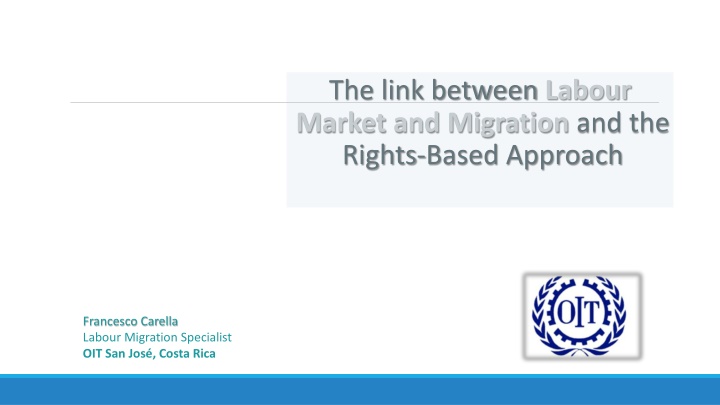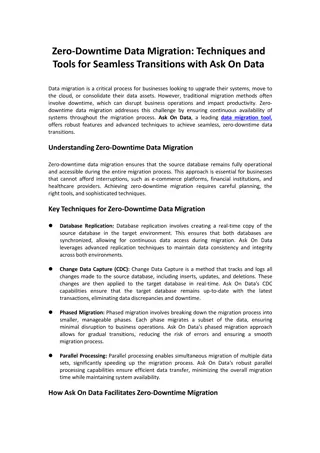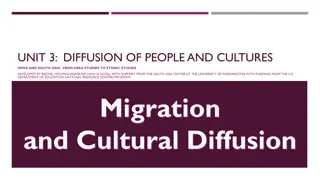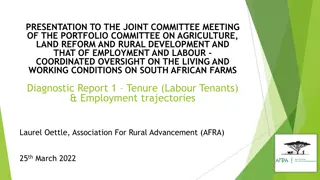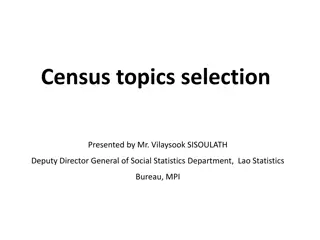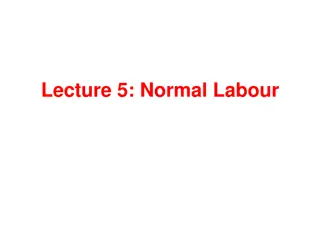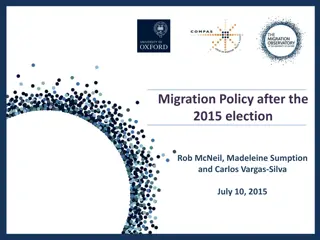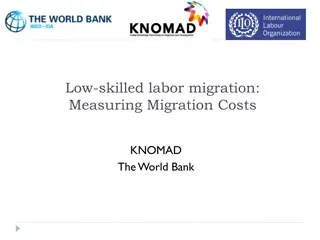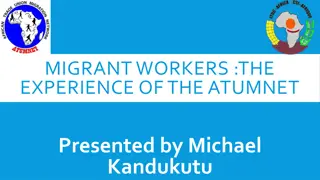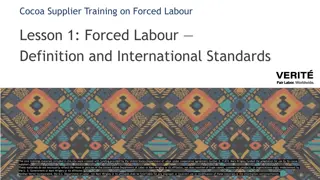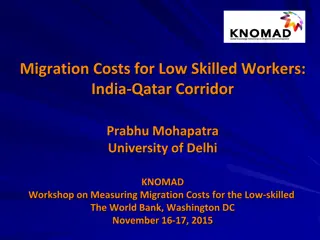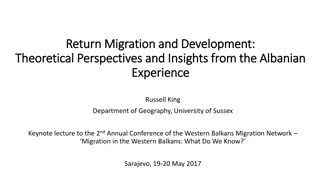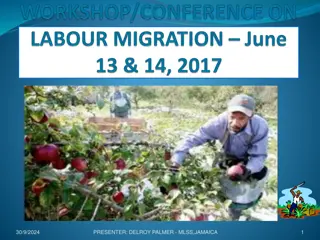The Link Between Labour Market and Migration: Understanding the Dynamics
Exploring the intricate relationship between labour market dynamics and migration, this content delves into the impact on poverty reduction, job creation, and professional reintegration. It highlights how economic opportunities, income changes, and workforce skill levels influence migration patterns, emphasizing the role of low-skilled workers and the effects on both origin and destination countries.
Download Presentation

Please find below an Image/Link to download the presentation.
The content on the website is provided AS IS for your information and personal use only. It may not be sold, licensed, or shared on other websites without obtaining consent from the author.If you encounter any issues during the download, it is possible that the publisher has removed the file from their server.
You are allowed to download the files provided on this website for personal or commercial use, subject to the condition that they are used lawfully. All files are the property of their respective owners.
The content on the website is provided AS IS for your information and personal use only. It may not be sold, licensed, or shared on other websites without obtaining consent from the author.
E N D
Presentation Transcript
The link between Labour Market and Migration and the Rights-Based Approach Francesco Carella Labour Migration Specialist OIT San Jos , Costa Rica
A complex, but ever more relevant link Individuals Indispensable to understand contemporary poverty reduction strategies in countries of origin and destination Groups/lobbys Applicable to Companies (optimize profits) Countries Unemployment Brain drain It has Informal economy Underemployment repercussions on Job creation through remittances Professional reintegration of migrants Salaries
Dynamics in countries of origin and destination Destino: Emitting: Employment and Underemployment Search for economic opportunities Wages Education and skill adquisition Concentraci n en la econom a informal Brain drain Reconocimiento y certificaci n de competencias Exit of the excess of unqualified workers Return
Search for economic opportunities Origin countries Most common factor leading to migration Migration reflects national disparities(supply and demand of certain types of workers) Migration and change in income According to a study(2010), 70-90% reported significative income increase Concentration in precarious works and with low wages 30 10% (majority didn t experimented) = no variation Few migrants lived an income decrease
Low-skilled workers Origin countries Labour market predetermines internal demand of workforce Emigration can contribute to relax saturated labour markets Decent work Markets requiring low- skilled workers are susceptibles to offer high proportions of low wages, underemployment y unemployment Hih underemployment levels and high supplies of low-skilled worforce = Vulnerable countries to emigration
Destination countries Employment and unemployment Initial conditions of the market Unemployment Employment State administration Debate about the contribution of migrants to unemplyment of natives Migrants mobilize toward zones of fast growth rate, higher wages and employment levels Studies highlights the absence of negative impacts Bridge workforce shortages Prform tasks rejected by natives Others even highlight a positive impact of migrants,vitalizing porduction and consumption Contribute to avoid high inflation Migrant contribution
Destination countries Wages Downward pressure Studies in western europe do not confirm the existence of such link Wages tend to resist the downward pressure and amiguity over the impact on employment Migration has negative impact on wages of low-skilled workers, but not statistically significant The level of organization of the migrants contribute to create differentiated impacts according to diasporas and receiving communities
Destination countries Recognition of skills Optimize the matching between migrants and the labour market necessities Origin Destination Socio-economic integration of the migrant according to it s education level Permit to foreign students recetly graduated to look for work Demand of high-skilled workers Bridge to deepen the skills of the migrants and to prepare a brighter return
Why is it necessary to promote this nexus? Origin countries Importance to develop integrated systems of information about migration flows Destination countries Better understand the links between labor migration and domestic policies Demographic realityof a population with problems of high aging process Favorish a migratory governance responding to necessities To confront challenges based on available knowledge Importance of the integration policies Political decisions about labor migrations benefiting national employment growth
Adopt a rights-based approach 2 specific conventions C143 (1975) Migrant workers (complementary dispositions) C97 (1949) Convention on the migrant worker Multilateral framework on labour migration(2006) Recommendation 086 (1949)- Migration for work Recommendation 151 (1975)- Migrant workers Complementary conventions C181 (1997) Private employment agencies convention C189 (2011) Domestic workers convention
Migration and Employment ILO s work Equitable migration program Tool Principle Increase the decent work opportunities in the countries of origin To make migration an option rather than a necessity for everyone ILO s support Elaborate labour migration policies or employment policies To enhance the regional social dialogue mecanisms Tecnical support to prepare bilateral agreements To develop recognition of skills and skill certification systems
Recommendations To deepen cooperation through bilateral agreements To base the legitimacy of labour migration policies on a broad social dialogue To foster the decent work in the emitting countries Equitable distribution of Objetivos prosperity that migrants contribute to create Improve the educative opportunities and enhance the skill certicification and recognition To promote coherence between employment and migration policies Ratify and comply with the pertinent international legislation
Conclusion and Debate Thank you for your attention! Any questions ?
